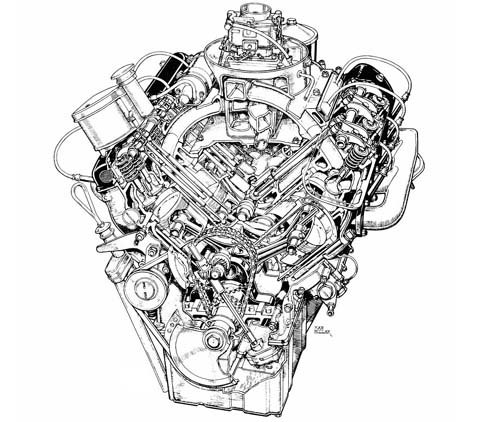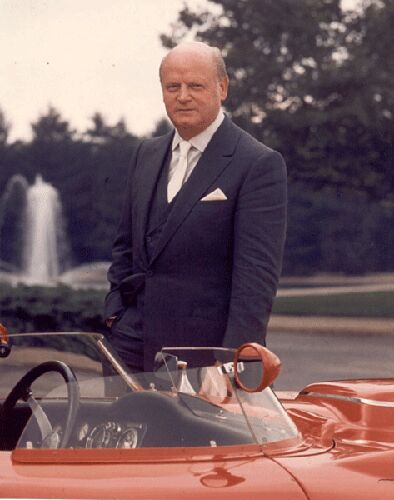#History
Book Review: Car Guys Vs Bean Counters: The Battle For The Soul Of American Business
I can’t say that I was completely surprised when, about two thirds of the way through Bob Lutz’s new book Car Guys vs Bean Counters, I caught a sideswipe at myself and The Truth About Cars, which the retired Vice-Chairman of GM describes as
a Web site that often offers anything but.
After all, TTAC and “Maximum Bob” have long been sparring partners, and were indirectly debating the fate and fortunes of General Motors well before I ever started writing about cars. What was surprising was that this passing shot at TTAC’s credibility would actually help bring us, two presumptive arch-enemies in the world of automotive ideas, to a better understanding of each other. The exchange that a single paragraph prompted taught me that, against all odds, Bob and I share a fundamental character trait: we are at our best when we’ve been goaded into action by a no-holds-barred call-out. In celebration of this shared value, let’s take off the gloves and give Car Guys the unflinching look it deserves.
For Memorial Day: The Arsenal of Democracy – The Independents
General Motors was the largest supplier of war materiel to the American armed forces. Ford famously built B-24 Liberators that rolled off the Willow Run assembly line at a rate of one per hour. Chrysler alone built as many tanks as all the German tank manufacturers combined. With those high profile contributions to the war effort made by the big three automakers, it’s easy to forget that the independent automakers (and automotive suppliers as well) also switched over completely to military production.
For Memorial Day: The Arsenal of Democracy – the Big 3 Go To War
To commemorate Memorial Day here in the US, we’re taking a look at how the American auto industry was mobilized into war production for World War Two. Because that mobilization was so extensive, the conversion to military production so complete, a blog post by it’s very nature cannot really do the subject justice. This is only the most cursory review of the topic, which truly deserves a book length treatment. As a matter of fact, historian Arthur Herman is currently working on a book about the “arsenal of democracy”, American industry during the war.
Herman will have a lot of material to work with.Today we’ll be looking at the role of the Big Three automakers in war production, starting with General Motors.
For Memorial Day: The Arsenal of Democracy
Memorial Day is a time set aside to remember those who gave their lives in military service to the United States. Today, even as we are fighting two wars and have men and women in harms way in yet other places, though, a relatively small fraction of Americans serve in the military. Few civilians, except military families, understand the sacrifices necessary to protect our country. There was a time, though, when the military conflict was genuinely existential and just about every able bodied man was drafted or enlisted, while virtually the entire civilian population was directly involved in the war effort, either through their jobs in military production, or more personally, because just about everything was rationed giving the military a higher priority for things like vehicles, tires, fuel and food. With the dawn of total war, the plants and proving grounds of Detroit became a new kind of battlefield, in which the tools of economic prosperity were turned into munitions and machines that would change the course of history.
What's Wrong With This Picture? Isadora Duncan Edition
Not that many fashion models have worked in machine shops, but most people should know that loose clothing and rotating objects don’t mix, or rather they mix too well. The cape streaming off of her neck may make for a nice photo but it could easily have led to some seriously negative publicity had that cape been snagged by a spinner on those knockoff wheels. Dancer Isadora Duncan’s penchant for long flowing scarves led to her demise in 1927. Riding in a friend’s Bugatti, she was strangled when one of her signature boas got caught in a rear wheel. One would think that at least one person at BMW or their ad company would have known about Duncan’s fate when they started tossing around ideas for a photo shoot to promote their new concept, the 328 Hommage. Apparently that wasn’t the case.
TTAC Contest: What Car Inspired GM's Panel-Gap Improvements?
The auto media has been receiving its advance copies of Bob Lutz’s forthcoming book “Car Guys versus Bean Counters” over the last few weeks, and have been leaking some of the more provocative statements and conclusions from it. I too requested a book and tore through it over the past week, enjoying Lutz’s direct voice and keen insights into his time at General Motors… as well as the attention-grabbing, politically-charged statements that the rest of the media seems so fixated upon. The bad news is that I won’t be able to write a full review until we get closer to its mid-June launch date, but the good news is that our forbearance has been rewarded: despite sideswiping yours truly in one passage, a brief but rewarding email conversation has generated more mutual respect, and Mr Lutz has agreed (in principle) to a TTAC interview to accompany our review at the time of the book’s release. Sometimes observing an embargo is worth it.
But fear not: just because the promise of an interview with one of the most influential figures in the industry has us delaying our review for another month or so, we’ve got more Lutz-related material with which to build up to what I expect to be a watershed interview for TTAC. Next week I’ll be publishing a review of Mr Maximum’s previous book “Guts,” and to kick of the coming months of Lutzmania, we’ve got a very special contest that is sure to stump even TTAC’s most well-versed Best and Brightest.
Elvis' Messerschmitt
Elvis Presley famously bought (and gave away) Cadillacs, lots of them. One of the first cars he bought after his first success with Sun Records was a 1955 Caddy, which caught fire and burned up out while on tour. Around that same time he bought Sun owner Sam Phillips a Cadillac as well. He bought a 1955 Fleetwood 60 Special and had it custom painted pink for his mother, Gladys, but she never drove it. There’s even a web site devoted just to Elvis’ Cadillacs. though he had at least a couple of notable Lincolns including a ’55 Continental that Ford had customized by Hess & Eisenhardt, the same company that made presidential limos. That web site documents about 30 Cadillacs known to be owned by the King, along with at least a score of Caddys that he gifted to friends and associates. The Cadillac fit Elvis’ image. They were big, bold, brash and fast. That big white Cadillac hearse that the king of rock and roll took for his last ride seemed particularly fitting. All it was missing were rhinestones. That’s why it’s a bit surprising to find out that Elvis owned and drove a tiny three-wheeler Messerschmitt micro car, and he owned it right around the time he couldn’t help falling in love with the much bigger Cadillacs.
Look At What I Found!: Packards Return to the Packard Proving Grounds Test Track – W/ Video
We’ve all seen too many pictures and videos of the magnificent ruin that was once the Packard plant on Detroit’s east side. It turns out that there’s a Packard site in the Detroit area that’s not a ruin, the Packard Proving Grounds in Shelby Twp. about 15 miles north of Eight Mile Road. Like the Packard plant on East Grand Blvd, Albert Kahn designed all the original Packard buildings on the proving grounds site, including a tudorish looking lodge where the facility’s manager and his family lived. It may be the only place where Kahn designed both residential and industrial buildings. It was built in 1927 at a cost of over a million dollars. Packard used the facility to develop and test their cars, aviation engines (there was a small airfield inside the big oval track – Charles Lindbergh visited the site), and also for publicity and marketing. The proving grounds even had a role in the Arsenal of Democracy. Chrysler used the facility during WWII to test Sherman tanks, erecting a building used to service the tanks that were tested inside the paved oval.
Additional video after the jump.
The Mystery Of The Fiat-Gaddafi Connection
Back in 1976, the Italian automaker Fiat had been badly battered by a global energy crisis and the resulting malaise infecting the global auto industry. In what Time Magazine described at the time as “a devastatingly ironic example of petropower,” Col. Muammar Gaddafi instructed his Libyan Arab Foreign Bank to invest some $415m into the Italian automaker, giving it a stake that would eventually grow to some 14 percent of the firm’s equity.
By 1986, Fiat’s Libyan stakeholders were becoming more trouble than they were worth. In the wake of the Lockerbie bombings, the US introduced sanctions on Libya, and Fiat’s Libyan connection left its attempts to bid for US military contracts (particularly those related to Ronald Reagan’s Strategic Defense Initiative) dead on arrival. As a result, Fiat and its shareholders bought back the entire 14 percent Libyan stake in the firm, presenting the Libyan Arab Foreign Bank-controlled Banca UBAE with a $3.1b check. And, according to what a Fiat spokesperson told us yesterday, that is where the story ends. But thanks to the now-ubiquitous Wikileaks, we have found that this story may in fact go farther than that. In fact, as the evidence stands right now, either the US State Department is working with bad information (which major news sources have yet to correct), or Fiat is lying about its ties to the embattled Gaddafi regime.
Regular, Premium, or… Opium?
TTAC's Toyota Recall Coverage: A Retrospective
[Ed: With today’s news of NHTSA’s investigation results, we thought we’d look back at TTAC’s coverage of the Toyota Unintended Acceleration scandal.]
The Toyota Unintended Acceleration Scandal of 2010 was a curious beastie of a media phenomenon. Shortly after I started writing for TTAC, NHTSA opened an investigation into Toyota Tacomas because, as the Center for Auto Safety’s Clarence Ditlow put it,
If there were truly human error, there would be a proportional distribution across models. It’s very difficult to explain how some makes and models have higher numbers of complaints than others absent some flaw in the vehicle.
Fresh as I was to writing about the world of cars, I was sure I had the story dead to rights. I had seen this movie before, when my father told me his epic Parnelli Jones Unintended Acceleration story. Dad had even killed the the family pickup’s engine at a traffic light to prove it… and I knew how bad the brakes in the old Ford were (but that’s another story). Absent a better explanation than mere statistical likelihood, I knew there was only one cause for this problem. With a level of confidence that seems totally at odds with subsequent events, I concluded by suggesting that
the Detroit Free Press and Motor Trend blog, are trying to resuscitate the [Audi 5000] media frenzy, only this time Toyota’s to blame for people mistaking the accelerator for their brake pedal… If a TTAC reader out there has a Tacoma, perhaps they would do us the honor of standing on the brakes while mashing the accelerator for a few seconds. This should prove fairly simply that “unintended acceleration” is possible only when you are not actually on the brakes.
It was that simple… wasn’t it?
Ask The Best And Brightest: Which Car Belongs In The Smithsonian?
Unfortunately, the question isn’t “what car belongs in the Smithsonian?” We could probably spend most of the holiday season discussing that one. No, the National Museum of American History has only 73 of the finest cars to choose from, and has nominated only eight to be displayed. You see, this isn’t one of those hypothetical deals… the NMAH actually wants you to vote on which car you think is most deserving of the honor, and the top-two vote-getters will be displayed from January 22- February 21. And your nominees are…
Debate Topic of the Day: Longest Production Run For Any Engine?
Here’s a question that may well be impossible to answer, due to the numerous gray areas involved. Sure, we could set all kinds of limitations (e.g., “production run” applies only to engines built by the original manufacturer) and of course you stumble into the quagmire of defining when changes to an engine design become significant enough to result in a different engine… but why should we do that?
Was GM Design Head Bill Mitchell A Sexist Bigot?
'Twas Ever Thus
Initial stock offerings, bankruptcies, brands being shuttered, established manufacturers being taken over by other concerns, financial crises – a time of turmoil in the auto industry. The time I’m describing is not just the present, it could well describe just about any period in automotive history. With the possible exception of the 1960s, when the Big 3 consolidated market share gained after the independent automakers were reduced to American Motors, there really never has been a long period of stability in the domestic auto industry. Even in the 1960s, Chrysler Corp. stumbled badly.
About a month ago Wayne State University Press, one of the leading publishers of automotive history books, sent me a box full of their recent titles, most of which concern the earliest days of the American auto industry: David Buick’s Marvelous Motor Car by Lawrence Gustin, Maxwell Motor and the Making of the Chrysler Corporation by Anthony J. Yanik, The Dodge Brothers: The Men, the Motor Cars, and the Legacy by Charles K. Hyde, and Hyde’s latest book, Storied Independent Automakers: Nash, Hudson, and American Motors.
While reading up on early American automotive history and I couldn’t help being struck by a sense of the more things change, the more they stay the same.



























Recent Comments